
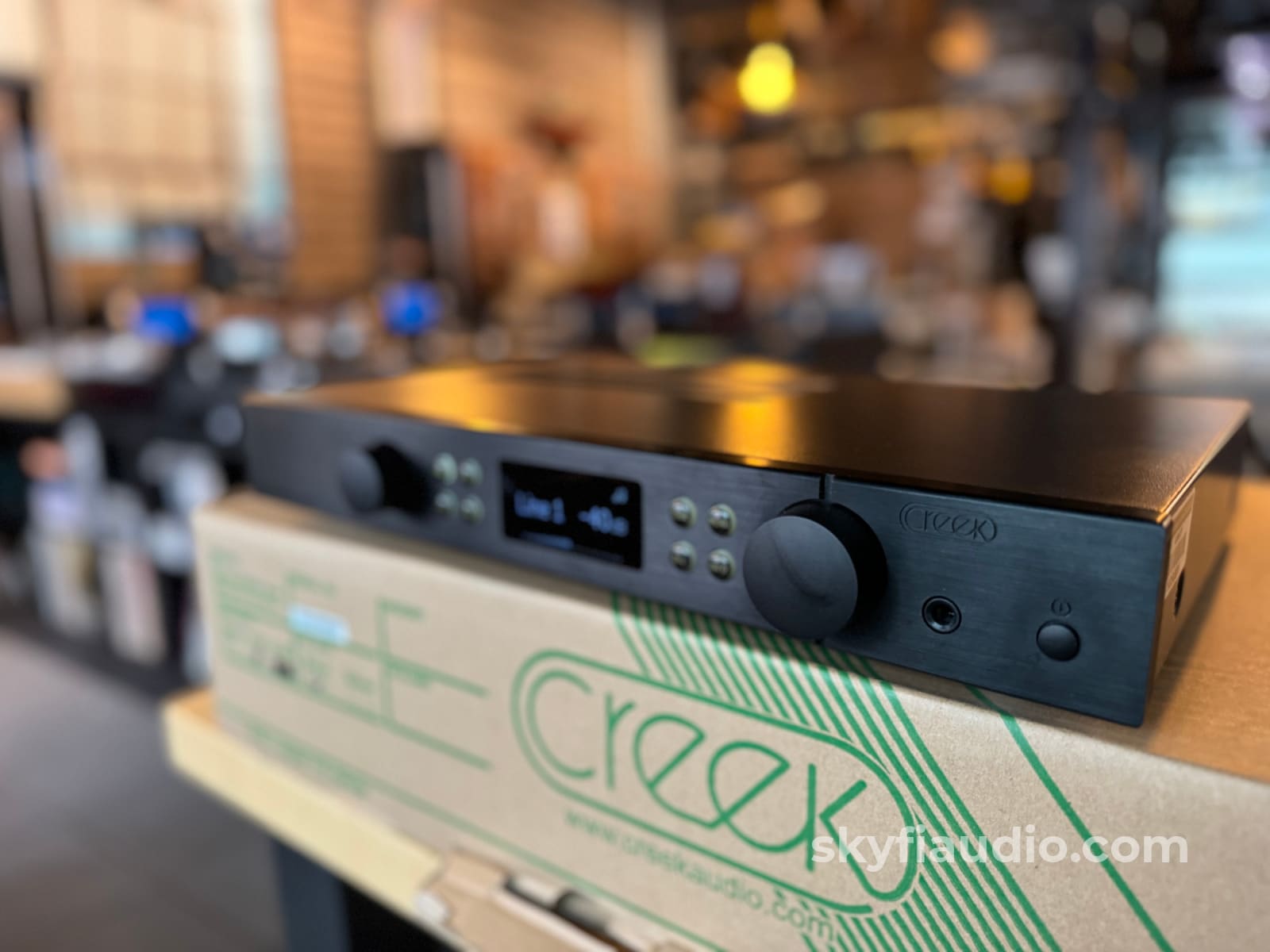

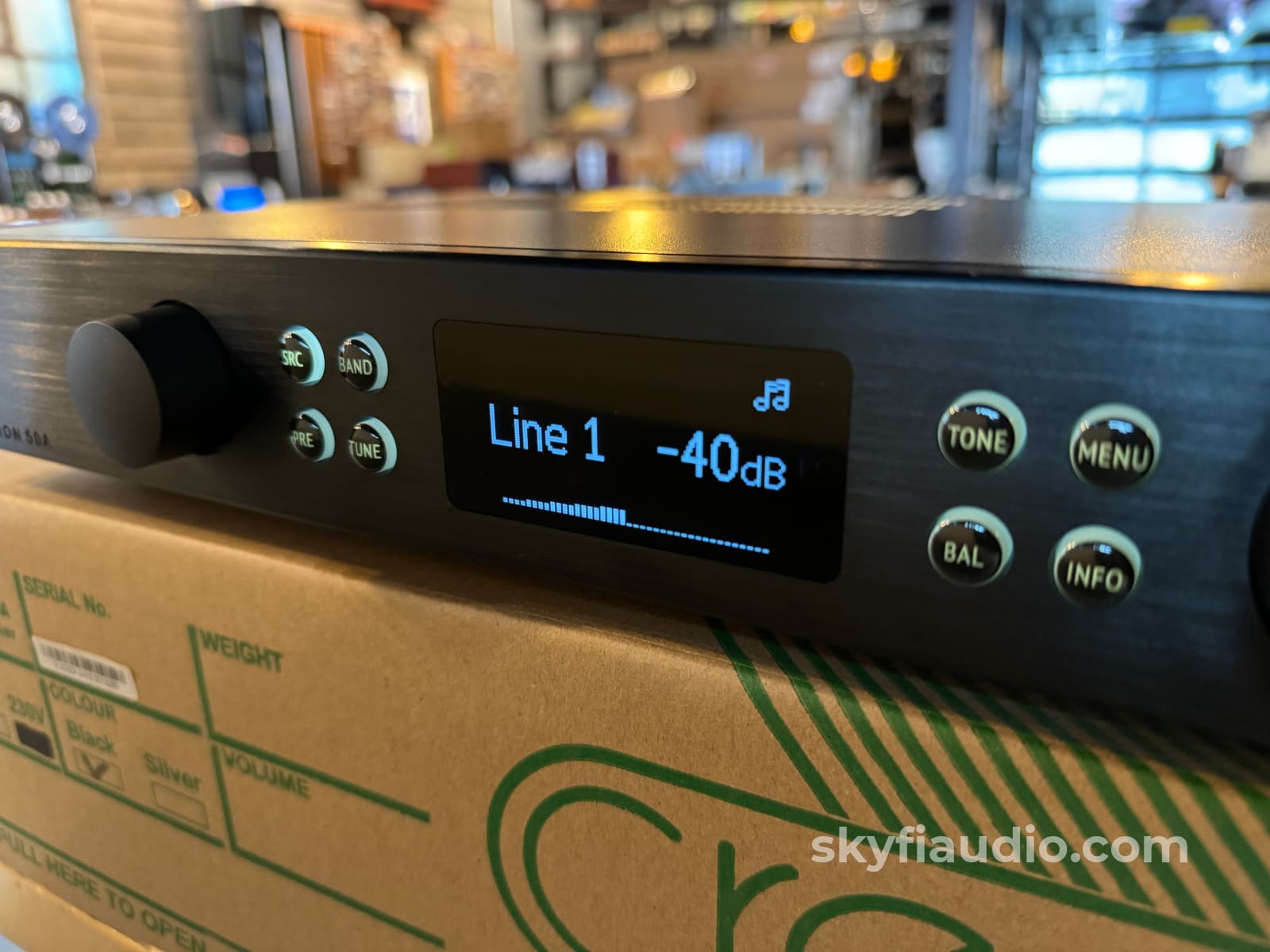
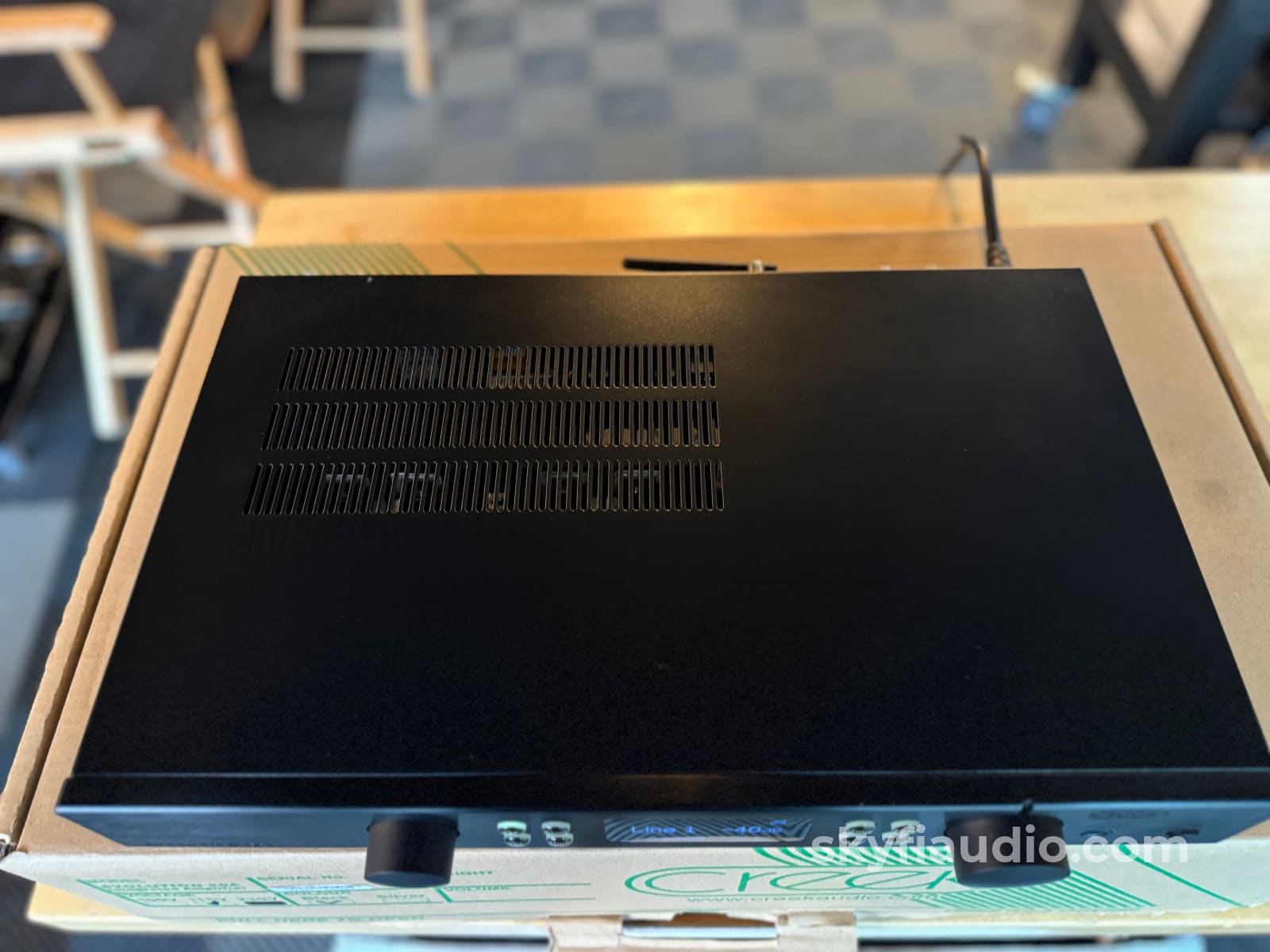


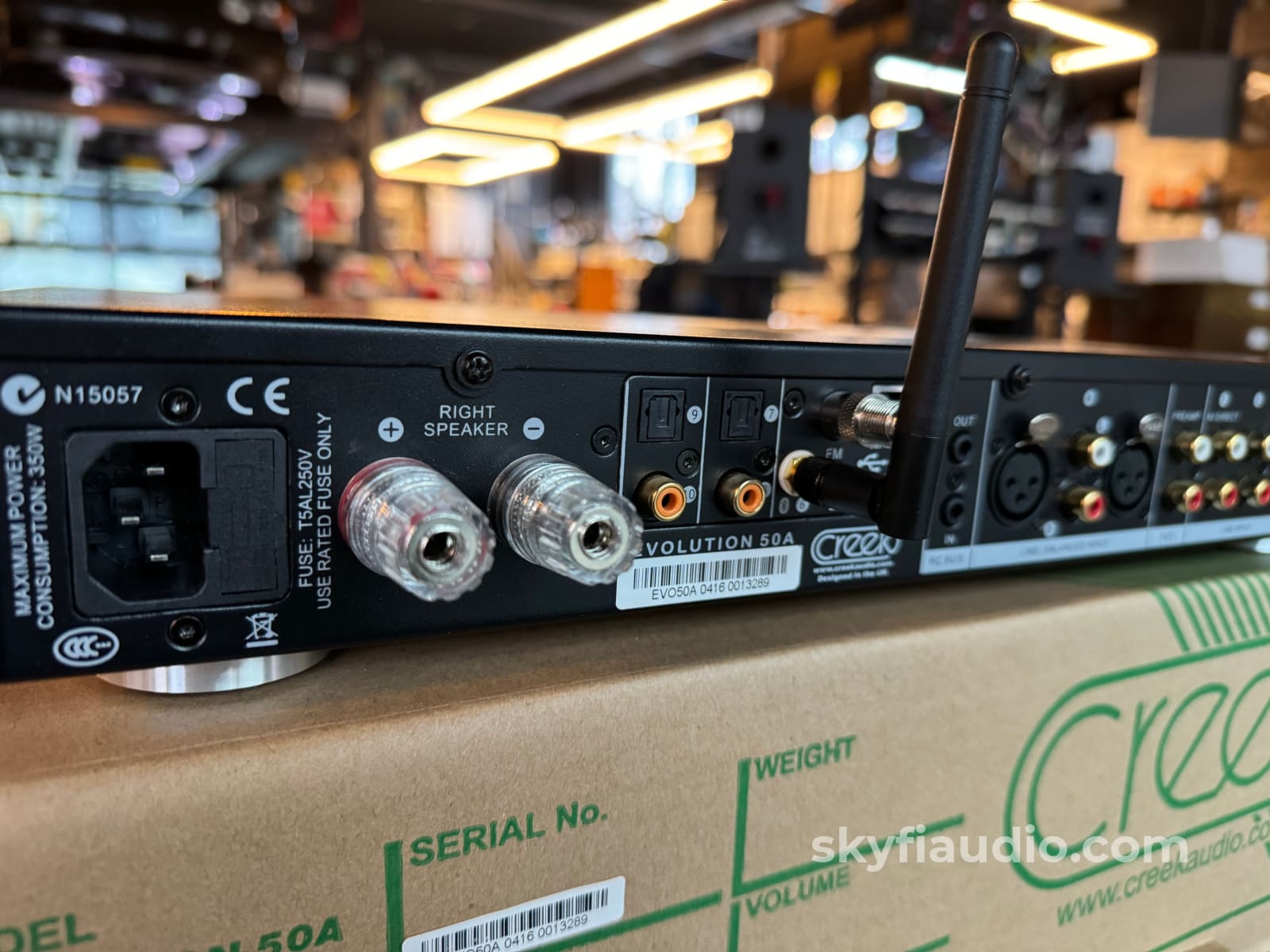
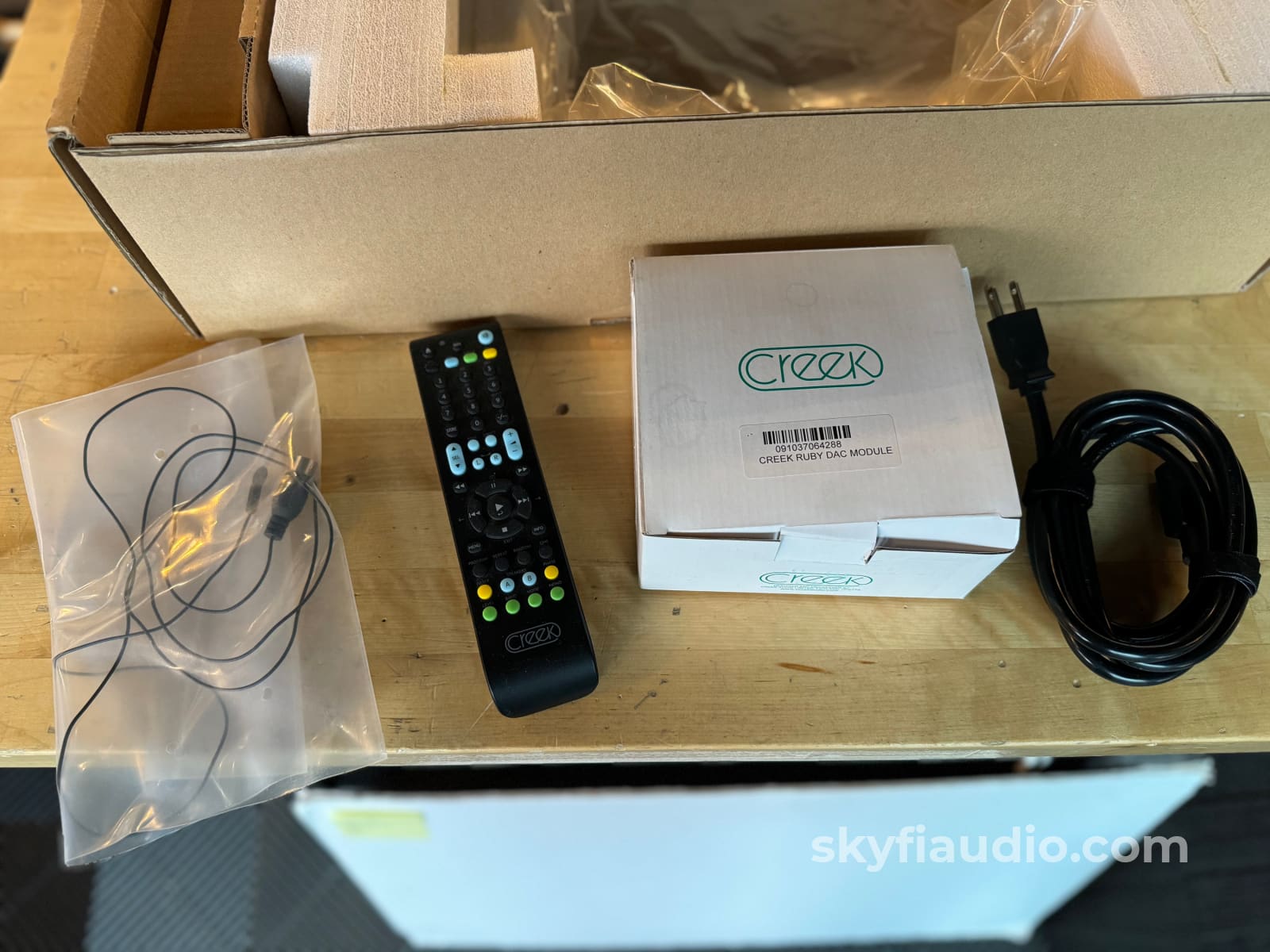
Creek Evolution 50A Integrated Amp w/Ruby 2 DAC Module - Complete
Free Shipping on Most Electronics - Excludes Speakers and Items Requiring Freight - Contiguous U.S. Only
Pickup currently unavailable at SkyFi 479

Creek Evolution 50A Integrated Amp w/Ruby 2 DAC Module - Complete
SkyFi 479
479 South Broad Street
Glen Rock NJ 07452
United States
General:
Like new and complete in its original box. Also upgraded with the Ruby 2 DAC module to make this a complete audio system.
The RUBY plug-in DAC module replaces Line Input 5.
It adds 2 x SPDIF, 2 x TOSLINK, USB, Bluetooth and FM radio inputs to the existing 4 line inputs.
More from Creek:
This new amplifier forms part of the next generation EVOLUTION 50 range of products. Housed in a slim case with engraved front panel and solid control knobs, it’s finished in either black or silver brushed aluminium. An ingenious new push button design has been developed for it, offering excellent tactile feel and backlit optical indication of usable functions for optimum user-friendliness.
Designed to match the high-end EVOLUTION 50CD.
The 50 series is the first Creek product to feature an OLED (Organic Light Emitting Diode) display. This white on black display provides higher clarity and resolution than a normal display and offers a wide range of customised graphic symbols. Display brightness levels can be changed or turn off when not required via the menu system.
At the heart of any good amplifier lies a good power supply; The EVOLUTION 50A uses a massive 200 Watt toroidal mains transformer with separate windings for high and low current analogue and digital circuitry. This produces a good power to weight ratio and low magnetic interference. Creek’s policy of paralleling several low impedance capacitors together, to create an ultra-high specification capacitor, to smooth the DC also helps to produce a very powerful and accurate sound from such a relatively small amplifier.
Creek’s Senior Engineer – David Gamble – who has much experience in the audio industry developed a completely new bi-polar transistor power amplifier circuit especially for the EVOLUTION 50A with very high open-loop gain and low distortion. Featuring a pair of Sanken 15 Amp power transistors, with built-in thermal compensation for rapid bias tracking performance, the Power Amplifier circuit has very low output impedance and can produce high output current. This combination will provide exceptional speed and control with most loudspeakers.
David also developed a completely new analogue Pre-amp circuit, providing high levels of flexibility and control, via unbalanced or balanced inputs. It has multiple input options, switched electronically or via gold contact relays, plus electronic Volume, Balance and Tone controls. For Vinyl fans, a Sequel 2 Phono pre-amp can be plugged-in, substituting Line Input 1 for Phono. In addition, Line input 5 is located on a Smart- Slot removable panel. Should the user want to fit a Tuner or DAC module, Line 5 input can be removed and replaced by either the AMBIT tuner or RUBY module.
Excellent measured and sonic performance has been achieved with this analogue integrated amp, but when using digital input signals via the matching EVOLUTION 50CD, the analogue pre-amp can be bypassed completely. The EVOLUTION 50CD has a very high-end volume control in the digital domain and ‘Class-A’ balanced audio outputs. Connecting the output directly to the “Power amp direct” inputs elevates the performance to an even higher level.
Creek Audio no longer makes a separate EVOLUTION Tuner, but die-hard analogue tuner fans can continue to listen using the top quality AMBIT plug-in tuner module, which augments the EVOLUTION 50A’s capabilities. The AMBIT and Ruby modules can be mounted to the back panel ‘Smart-Slot’, replacing Line Input 5. When the AMBIT is fitted, it automatically turns the amp into a Receiver, suitable for use in every region of the world. The OLED shows tuner functions and buttons and knobs have dual functions.
The RUBY plug-in DAC module also replaces Line Input 5. It adds 2 x SPDIF, 2 x TOSLINK, USB, Bluetooth and FM radio inputs to the existing 4 line inputs.
The EVOLUTION 50A can also be configured for Vinyl Disc input, in place of Line input 1. The SEQUEL 2 module plugs into dedicated connectors on the pre-amp PCB and can run simultaneously with the AMBIT or RUBY. It comes in three versions – 40dB – 48dB and 54dB MM and MC.
To simplify the many options a stylish new system remote handset has been developed to control all the functions of the EVOLUTION 50 range. The EVOLUTION 50 range also features an optional IR extender to enable the products to be hidden away, but still operable via remote control.
Technical Specifications
Power Output:
>55 Watts into 8 Ohms
Power Output:
>85 Watts into 4 Ohms
Continuous Current:
>8.5 Amps (sine wave)
Max Current:
>26 Amps, current burst into 0.5 Ohms
Output Impedance:
<0.1 Ohms @ 1Khz
THD:
<0.005% 20 Hz – 20 Khz
SNR:
>102dB
Frequency Response:
10 Hz – 100 KHz +/- 2dB
Line Gain:
33.3dB (x46) via power amp input
Input Sensitivity:
410mV
Crosstalk:
-80 dB at 1Khz
DC Offset:
< ±10mV
Slew Rate:
> 30 V per µS
Operating Voltages:
110V / 230V
Weight;
16.53 lbs / 7.5 Kg
Dimensions
16.93" x 2.36" x 11.02" / 430 x 60 x 280mm W/H/D
Cosmetic Condition:
8 / 10 - See our detailed rating description here.
Working Condition:
Working perfectly and tested in our lab and listening room.
Reviews:
Click Here
Recommended Cables:
Kimber Kable - BALANCED XLR Connectors - Better
Kimber Kable - RCA Interconnects - Better
Kimber Kable - Phono Interconnects - Better
Kimber Kable - Coaxial Digital Interconnect
Kimber Kable - Optical Digital Interconnect
The SkyFi Testing Process for Integrated Amplifiers:
We start with a visual inspection of all internal components to make sure that there are no signs of heat stress or damage. Capacitors are checked for telltale signs of predictive failure including bulging, shrunken wrappers, or physical leakage. We also inspect the PCBs for discoloration from resistors or transistors that may have been running hot. On vintage units we often spot check select capacitors for value and ESR.
If the device has the ability to decouple the preamplifier from the power amplifier, we remove the jumpers and independently test each section. If the device cannot be decoupled, we assess the electronic condition of the piece by analyzing the speaker level output only.
We start by connecting the “preout” jacks of the integrated to a Sencore PA81 Power Analyzer which simulates real world loading conditions and gives us an oscilloscope interface. The first order of business is checking that the volume control works smoothly throughout its entire range with acceptable channel balance. This is accomplished by feeding a 1KHz sine wave into one of the preamp’s line level inputs while monitoring the preamp’s output on an oscilloscope. We then switch to a 1KHz square wave to test the tone controls, loudness function, and filters where applicable. During this step we are watching for equal alteration of the test signal by both channels. This also helps us identify dirty controls that will need treatment. Once the basic line stage functions are verified, we test each input individually. This is especially important for devices that use relays to select their sources. If the preamp section is equipped with a phono stage we test that as well. We use an inverse RIAA filter which allows us to feed a reference test signal into the phono input with the proper RIAA equalization and level. A square wave or sine sweep is used to verify that the device’s phono stage is faithfully reproducing the RIAA curve.
Next, we test the power amplifier section by connecting the integrated’s speaker outputs to a Sencore PA81 Power Analyzer which acts as a dummy load, DC offset monitor, and oscilloscope interface. We start with a low level 1KHz test signal at the “main in” jacks and slowly increase its amplitude while monitoring the output on an oscilloscope for signs of noise, clipping, distortion, or improper channel balance. We continue increasing the signal level until the amplifier reaches clipping. At this point we take an output power measurement and compare it to the spec sheet of the amplifier to verify proper performance.We finish off the bench evaluation with a 1KHz square wave check and a 20Hz to 20KHz sine sweep to assess the amplifier’s frequency response characteristics. This battery of tests will usually reveal if the amplifier has any issues that need further attention.
If the preamp and power amp both pass these tests, we reconnect the sections and verify that the preamp section can drive the power amp to rated power with a 1KHz tone on one of the line level inputs.
Before the device leaves the bench, we perform a listening test with actual music using a variety of preferred test tracks. Our benches are outfitted with familiar monitor speakers which help us identify inconsistencies that will not always show up on our test gear. The main things that we are listening for are hum or noise with no signal present, proper center image, clicks, pops, or any other obvious undesirable audio characteristics.
If the unit passes all of these tests it is moved to our long term testing rig where we simulate real word operating conditions for 6-8 hours. This allows us to monitor the unit for signs of thermal runaway or intermittent issues that only crop up when the unit has fully come up to temperature.
The SkyFi Testing Process for DACs:
We start with a visual inspection of all internal components to make sure that there are no signs of heat stress or damage. Capacitors are checked for telltale signs of predictive failure including bulging, shrunken wrappers, or physical leakage. We also inspect resistors and other passive components for signs of overheating.
After the visual inspection we connect the DAC’s RCA outputs to our Sencore PA81 Power Analyzer which simulates a real world input impedance and allows us to monitor the output on an oscilloscope. We are equipped to test optical, coaxial, and USB inputs at Redbook CD Quality. We start with a test signal to verify signal lock and proper output on both channels. If the DAC has balanced outputs these are also tested at this time. If the DAC has multiple Optical and Coaxial inputs they are all checked for proper lock. USB inputs are tested with a Macbook Pro.
After proper function is verified, we set the DAC up for a listening test to evaluate general audio reproduction quality and monitor for clicks, pops, or any other audible signs of issues related to dropped signal lock or failing audio output stages. We often connect DACs under evaluation to our long term test rig for a long test stint to verify stability under real world operating conditions.
Choose options
